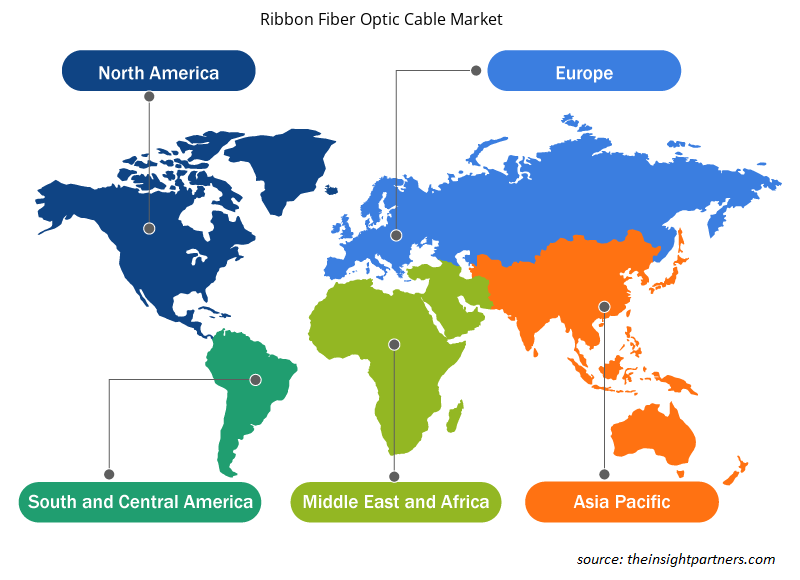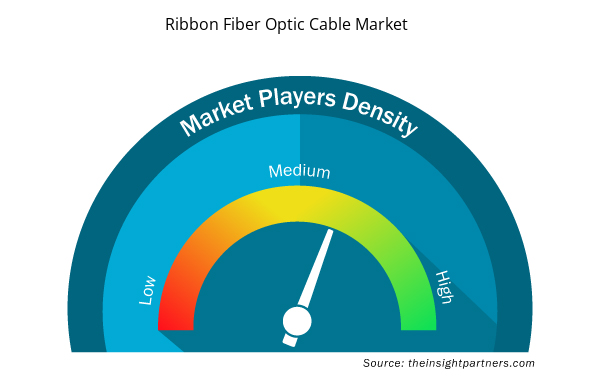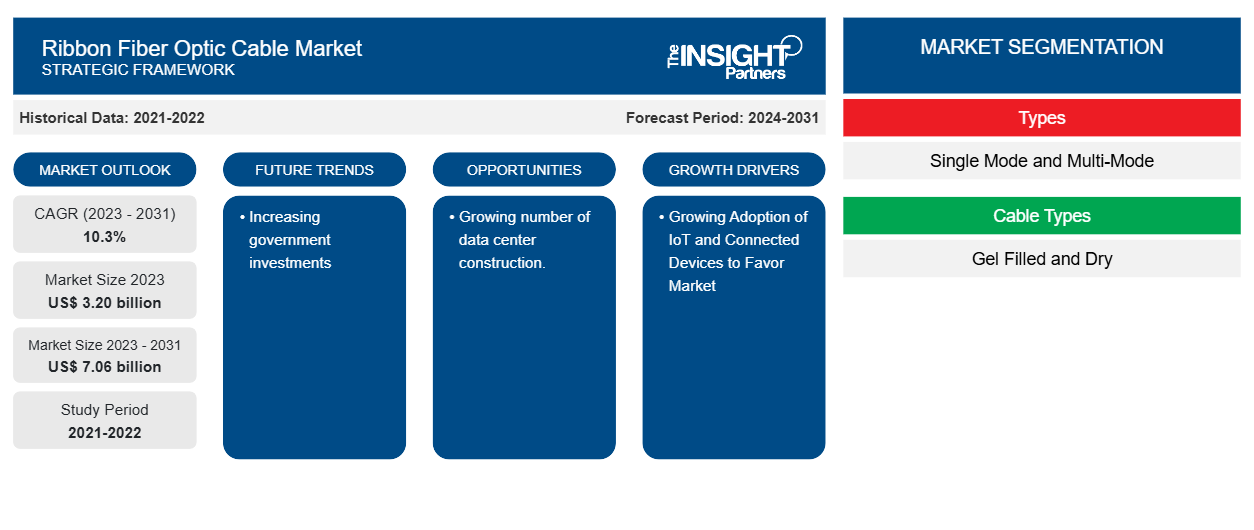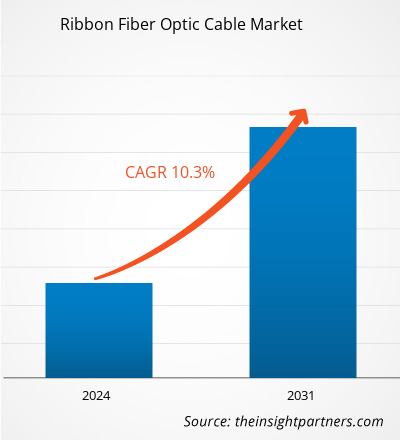Der Markt für Flachband-Glasfaserkabel soll von 3,20 Milliarden US-Dollar im Jahr 2023 auf 7,06 Milliarden US-Dollar im Jahr 2031 anwachsen. Der Markt soll zwischen 2023 und 2031 eine durchschnittliche jährliche Wachstumsrate (CAGR) von 10,3 % verzeichnen. Die steigende Nachfrage nach Flachband-Glasfaserkabeln in wachsenden Volkswirtschaften und die Zunahme der Zahl der gebauten Rechenzentren dürften weiterhin die wichtigsten Trends auf dem Markt für Flachband-Glasfaserkabel bleiben.
Marktanalyse für Flachbandkabel aus Glasfaser
Der globale Markt für Glasfaserkabel wird aufgrund ihrer weit verbreiteten Verwendung in zahlreichen Endverbrauchsbranchen wachsen. Die größere Reichweite und die höheren Bandbreitenverbindungen von Glasfaserkabeln werden voraussichtlich einen erheblichen Einfluss auf die Wachstumsstruktur des Marktes haben. Darüber hinaus wird erwartet, dass die starke Tendenz in der Rechenzentrums- und Telekommunikationsbranche die Wachstumsaussichten des Glasfaserkabelmarktes steigern wird.
Marktübersicht für Flachbandkabel
Flachbandkabel aus Glasfaser sind im Gegensatz zu optischen Strahlkabeln als Streifen angeordnet. Flachbandkabel aus Glasfaser sind eine praktische Lösung für Gewichts- und Platzprobleme. Wie eine kleine Version der in der Computerverkabelung verwendeten Drahtbänder bestehen die Kabelbänder aus beschichteten Glasfasern, die nebeneinander angeordnet und in Mylarband eingefasst sind. Da das Band nur aus beschichteten Glasfasern besteht, benötigt diese Art von Kabel viel weniger Platz als einzeln gepufferte Glasfasern. Flachbandkabel sind daher dichter als jede andere Kabelkonfiguration. Für Anwendungen mit Platzmangel sind sie perfekt geeignet.
Passen Sie diesen Bericht Ihren Anforderungen an
Sie erhalten kostenlos individuelle Anpassungen an jedem Bericht, einschließlich Teilen dieses Berichts oder einer Analyse auf Länderebene, eines Excel-Datenpakets sowie tolle Angebote und Rabatte für Start-ups und Universitäten.
- Holen Sie sich die wichtigsten Markttrends aus diesem Bericht.Dieses KOSTENLOSE Beispiel umfasst eine Datenanalyse von Markttrends bis hin zu Schätzungen und Prognosen.
Treiber und Chancen auf dem Markt für Flachbandkabel
Zunehmende Nutzung von IoT und vernetzten Geräten begünstigt den Markt
In Schwellenländern steigt der Bedarf an Infrastruktur, darunter auch Telekommunikationsnetze. Glasfaserkabel mit Flachbandkabeln bieten eine höhere Dichte und sind einfacher zu installieren, was sie für den schnellen Ausbau von Netzwerken attraktiv macht. Mit der Modernisierung der Schwellenländer steigt auch die Nachfrage nach Internetkonnektivität, sowohl für Unternehmen als auch für Privatpersonen. Glasfaserkabel mit Flachbandkabeln können höhere Datenübertragungsraten unterstützen und ermöglichen so schnellere und zuverlässigere Internetverbindungen.
Immer mehr Rechenzentrumsbauten werden errichtet.
Die steigende Nachfrage nach einem stetigen Anstieg der Anzahl von Rechenzentren bietet eine Chance für den Markt für Glasfaserkabel mit Flachbandkabeln, da diese Kabel eine höhere Dichte und einfachere Verwaltung bieten und sich daher ideal für die hochdichten Umgebungen von Rechenzentren eignen. Sie können mehr Fasern auf kleinerem Raum unterbringen, was gut zu den Anforderungen expandierender Rechenzentren passt, die nach mehr Kapazität und Effizienz streben.
Segmentierungsanalyse des Marktberichts für Glasfaserbandkabel
Wichtige Segmente, die zur Ableitung der Marktanalyse für Flachbandkabel aus Glasfaser beigetragen haben, sind Typ, Kabeltypen und Anwendung.
- Basierend auf dem Typ wird der Markt für Flachbandkabel in Singlemode und Multimode unterteilt. Das Singlemode-Segment dürfte im Prognosezeitraum wachsen.
- Nach Anwendung ist der Markt in KMU und Großunternehmen segmentiert. Das Markensegment dürfte im Prognosezeitraum wachsen.
- Basierend auf den Kabeltypen wird der Markt für Glasfaserbandkabel in gelgefüllte und trockene unterteilt. Das gelgefüllte Segment dürfte im Prognosezeitraum wachsen.
Marktanteilsanalyse für Flachbandkabel nach geografischen Gesichtspunkten
Der geografische Umfang des Berichts zum Markt für Flachband-Glasfaserkabel ist hauptsächlich in fünf Regionen unterteilt: Nordamerika, Asien-Pazifik, Europa, Naher Osten und Afrika sowie Südamerika/Süd- und Mittelamerika. Nordamerika hat den Markt für Flachband-Glasfaserkabel dominiert. Hochtechnologische Trends in verschiedenen Branchen in der nordamerikanischen Region haben das Wachstum des Marktes für Flachband-Glasfaserkabel angekurbelt. Faktoren wie die zunehmende Einführung digitaler Tools und hohe Technologieausgaben von Regierungsbehörden werden voraussichtlich das Wachstum des nordamerikanischen Marktes für Flachband-Glasfaserkabel vorantreiben. Darüber hinaus zwingt eine starke Betonung von Forschung und Entwicklung in den entwickelten Volkswirtschaften der USA und Kanadas die nordamerikanischen Akteure dazu, technologisch fortschrittliche Lösungen auf den Markt zu bringen. Darüber hinaus gibt es in den USA eine große Anzahl von Akteuren auf dem Markt für Flachband-Glasfaserkabel, die sich zunehmend auf die Entwicklung innovativer Lösungen konzentrieren. All diese Faktoren tragen zum Wachstum des Marktes für Flachband-Glasfaserkabel in der Region bei.
Regionale Einblicke in den Markt für Flachbandkabel
Die regionalen Trends und Faktoren, die den Markt für Glasfaserbandkabel im Prognosezeitraum beeinflussen, wurden von den Analysten von Insight Partners ausführlich erläutert. In diesem Abschnitt werden auch die Marktsegmente und die Geografie von Glasfaserbandkabeln in Nordamerika, Europa, im asiatisch-pazifischen Raum, im Nahen Osten und Afrika sowie in Süd- und Mittelamerika erörtert.

- Erhalten Sie regionale Daten zum Markt für Flachbandkabel
Umfang des Marktberichts über Glasfaserbandkabel
| Berichtsattribut | Details |
|---|---|
| Marktgröße im Jahr 2023 | 3,20 Milliarden US-Dollar |
| Marktgröße bis 2031 | 7,06 Milliarden US-Dollar |
| Globale CAGR (2023 - 2031) | 10,3 % |
| Historische Daten | 2021-2022 |
| Prognosezeitraum | 2024–2031 |
| Abgedeckte Segmente | Nach Typ
|
| Abgedeckte Regionen und Länder | Nordamerika
|
| Marktführer und wichtige Unternehmensprofile |
|
Marktteilnehmerdichte: Der Einfluss auf die Geschäftsdynamik
Der Markt für Glasfaserbandkabel wächst rasant, angetrieben durch die steigende Nachfrage der Endnutzer aufgrund von Faktoren wie sich entwickelnden Verbraucherpräferenzen, technologischen Fortschritten und einem größeren Bewusstsein für die Vorteile des Produkts. Mit steigender Nachfrage erweitern Unternehmen ihr Angebot, entwickeln Innovationen, um die Bedürfnisse der Verbraucher zu erfüllen, und nutzen neue Trends, was das Marktwachstum weiter ankurbelt.
Die Marktteilnehmerdichte bezieht sich auf die Verteilung von Firmen oder Unternehmen, die in einem bestimmten Markt oder einer bestimmten Branche tätig sind. Sie gibt an, wie viele Wettbewerber (Marktteilnehmer) in einem bestimmten Marktraum im Verhältnis zu seiner Größe oder seinem gesamten Marktwert präsent sind.
Die wichtigsten auf dem Markt für Flachbandkabel tätige Unternehmen sind:
- CommScope, Inc.
- Corning Incorporated
- Fujikura Ltd.
- OFS Fitel, LLC.
- Prysmian SpA
Haftungsausschluss : Die oben aufgeführten Unternehmen sind nicht in einer bestimmten Reihenfolge aufgeführt.

- Überblick über die wichtigsten Akteure auf dem Markt für Flachbandkabel
Neuigkeiten und aktuelle Entwicklungen zum Markt für Flachbandkabel
Der Markt für Flachbandkabel wird durch die Erhebung qualitativer und quantitativer Daten nach Primär- und Sekundärforschung bewertet, die wichtige Unternehmensveröffentlichungen, Verbandsdaten und Datenbanken umfasst. Im Folgenden finden Sie eine Liste der Entwicklungen auf dem Markt:
- Im Oktober 2023 gab HFCL die Markteinführung seines intermittierend verbundenen Flachbandkabels 1728 bekannt. Das Unternehmen kündigte außerdem an, dass es die wachsende Nachfrage von Rechenzentren befriedigen und gleichzeitig die 5G-Netzwerkinfrastruktur stärken werde.
(Quelle: HFCL, Pressemitteilung, 2023)
- Im März 2024 gab Opticonx, ein in den USA ansässiger Hersteller von Glasfaserkabelkomponenten und -systemen und eine hundertprozentige Tochtergesellschaft von Precision Optical Technologies, eine exklusive globale Vertriebsvereinbarung mit Fiber Optic Center, Inc. (FOC) bekannt. Als Ergebnis dieser Partnerschaft wird FOC, ein führender internationaler Distributor von Glasfaserkomponenten, -geräten und -zubehör, dazu beitragen, die hochwertigen/innovativen LightTube-Glasfaser-Furkations- und Breakout-Rohrprodukte von Opticonx der breiteren optischen Netzwerkbranche zugänglich zu machen.
(Quelle: Opticonx, Pressemitteilung, 2022)
Marktbericht zu Glasfaserbandkabeln – Umfang und Ergebnisse
Der "Der Bericht „Marktgröße und Prognose für Flachbandkabel-Glasfasern (2021–2031)“ bietet eine detaillierte Analyse des Marktes, die die folgenden Bereiche abdeckt:
- Marktgröße und Prognose auf globaler, regionaler und Länderebene für alle abgedeckten wichtigen Marktsegmente.
- Marktdynamik wie Treiber, Beschränkungen und wichtige Chancen
- Wichtige Zukunftstrends
- Detaillierte PEST/Porters Five Forces- und SWOT-Analyse
- Globale und regionale Marktanalyse, die wichtige Markttrends, wichtige Akteure, Vorschriften und aktuelle Marktentwicklungen abdeckt.
- Branchenlandschaft und Wettbewerbsanalyse, einschließlich Marktkonzentration, Heatmap-Analyse, prominenten Akteuren und aktuellen Entwicklungen.
- Detaillierte Firmenprofile
- Historische Analyse (2 Jahre), Basisjahr, Prognose (7 Jahre) mit CAGR
- PEST- und SWOT-Analyse
- Marktgröße Wert/Volumen – Global, Regional, Land
- Branche und Wettbewerbsumfeld
- Excel-Datensatz



Report Coverage
Revenue forecast, Company Analysis, Industry landscape, Growth factors, and Trends

Segment Covered
This text is related
to segments covered.

Regional Scope
North America, Europe, Asia Pacific, Middle East & Africa, South & Central America

Country Scope
This text is related
to country scope.
Häufig gestellte Fragen
The global ribbon fiber optic cable market was estimated to be US$ 3.20 billion in 2023 and is expected to grow at a CAGR of 10.3% during the forecast period 2024 - 2031.
Increasing demand for ribbon fiber optic cable demands in growing economies are the major factors that propel the global ribbon fiber optic cable market growth.
A growing number of data center construction is anticipated to play a significant role in the global ribbon fiber optic cable market in the coming years.
The key players holding majority shares in the global ribbon fiber optic cable market are CommScope, Inc., Corning Incorporated, Fujikura Ltd., OFS Fitel, LLC., Prysmian S.p.A, STL Tech, NEXANS, Sumitomo Electric Lightwave, Inc., Siemon, Yangtze Optical Fibre and Cable Joint Stock Limited Company.
The global ribbon fiber optic cable market is expected to reach US$ 7.06 billion by 2031.
Trends and growth analysis reports related to Electronics and Semiconductor : READ MORE..
The Insight Partners performs research in 4 major stages: Data Collection & Secondary Research, Primary Research, Data Analysis and Data Triangulation & Final Review.
- Data Collection and Secondary Research:
As a market research and consulting firm operating from a decade, we have published and advised several client across the globe. First step for any study will start with an assessment of currently available data and insights from existing reports. Further, historical and current market information is collected from Investor Presentations, Annual Reports, SEC Filings, etc., and other information related to company’s performance and market positioning are gathered from Paid Databases (Factiva, Hoovers, and Reuters) and various other publications available in public domain.
Several associations trade associates, technical forums, institutes, societies and organization are accessed to gain technical as well as market related insights through their publications such as research papers, blogs and press releases related to the studies are referred to get cues about the market. Further, white papers, journals, magazines, and other news articles published in last 3 years are scrutinized and analyzed to understand the current market trends.
- Primary Research:
The primarily interview analysis comprise of data obtained from industry participants interview and answers to survey questions gathered by in-house primary team.
For primary research, interviews are conducted with industry experts/CEOs/Marketing Managers/VPs/Subject Matter Experts from both demand and supply side to get a 360-degree view of the market. The primary team conducts several interviews based on the complexity of the markets to understand the various market trends and dynamics which makes research more credible and precise.
A typical research interview fulfils the following functions:
- Provides first-hand information on the market size, market trends, growth trends, competitive landscape, and outlook
- Validates and strengthens in-house secondary research findings
- Develops the analysis team’s expertise and market understanding
Primary research involves email interactions and telephone interviews for each market, category, segment, and sub-segment across geographies. The participants who typically take part in such a process include, but are not limited to:
- Industry participants: VPs, business development managers, market intelligence managers and national sales managers
- Outside experts: Valuation experts, research analysts and key opinion leaders specializing in the electronics and semiconductor industry.
Below is the breakup of our primary respondents by company, designation, and region:

Once we receive the confirmation from primary research sources or primary respondents, we finalize the base year market estimation and forecast the data as per the macroeconomic and microeconomic factors assessed during data collection.
- Data Analysis:
Once data is validated through both secondary as well as primary respondents, we finalize the market estimations by hypothesis formulation and factor analysis at regional and country level.
- Macro-Economic Factor Analysis:
We analyse macroeconomic indicators such the gross domestic product (GDP), increase in the demand for goods and services across industries, technological advancement, regional economic growth, governmental policies, the influence of COVID-19, PEST analysis, and other aspects. This analysis aids in setting benchmarks for various nations/regions and approximating market splits. Additionally, the general trend of the aforementioned components aid in determining the market's development possibilities.
- Country Level Data:
Various factors that are especially aligned to the country are taken into account to determine the market size for a certain area and country, including the presence of vendors, such as headquarters and offices, the country's GDP, demand patterns, and industry growth. To comprehend the market dynamics for the nation, a number of growth variables, inhibitors, application areas, and current market trends are researched. The aforementioned elements aid in determining the country's overall market's growth potential.
- Company Profile:
The “Table of Contents” is formulated by listing and analyzing more than 25 - 30 companies operating in the market ecosystem across geographies. However, we profile only 10 companies as a standard practice in our syndicate reports. These 10 companies comprise leading, emerging, and regional players. Nonetheless, our analysis is not restricted to the 10 listed companies, we also analyze other companies present in the market to develop a holistic view and understand the prevailing trends. The “Company Profiles” section in the report covers key facts, business description, products & services, financial information, SWOT analysis, and key developments. The financial information presented is extracted from the annual reports and official documents of the publicly listed companies. Upon collecting the information for the sections of respective companies, we verify them via various primary sources and then compile the data in respective company profiles. The company level information helps us in deriving the base number as well as in forecasting the market size.
- Developing Base Number:
Aggregation of sales statistics (2020-2022) and macro-economic factor, and other secondary and primary research insights are utilized to arrive at base number and related market shares for 2022. The data gaps are identified in this step and relevant market data is analyzed, collected from paid primary interviews or databases. On finalizing the base year market size, forecasts are developed on the basis of macro-economic, industry and market growth factors and company level analysis.
- Data Triangulation and Final Review:
The market findings and base year market size calculations are validated from supply as well as demand side. Demand side validations are based on macro-economic factor analysis and benchmarks for respective regions and countries. In case of supply side validations, revenues of major companies are estimated (in case not available) based on industry benchmark, approximate number of employees, product portfolio, and primary interviews revenues are gathered. Further revenue from target product/service segment is assessed to avoid overshooting of market statistics. In case of heavy deviations between supply and demand side values, all thes steps are repeated to achieve synchronization.
We follow an iterative model, wherein we share our research findings with Subject Matter Experts (SME’s) and Key Opinion Leaders (KOLs) until consensus view of the market is not formulated – this model negates any drastic deviation in the opinions of experts. Only validated and universally acceptable research findings are quoted in our reports.
We have important check points that we use to validate our research findings – which we call – data triangulation, where we validate the information, we generate from secondary sources with primary interviews and then we re-validate with our internal data bases and Subject matter experts. This comprehensive model enables us to deliver high quality, reliable data in shortest possible time.


 Holen Sie sich ein kostenloses Muster für diesen Bericht
Holen Sie sich ein kostenloses Muster für diesen Bericht